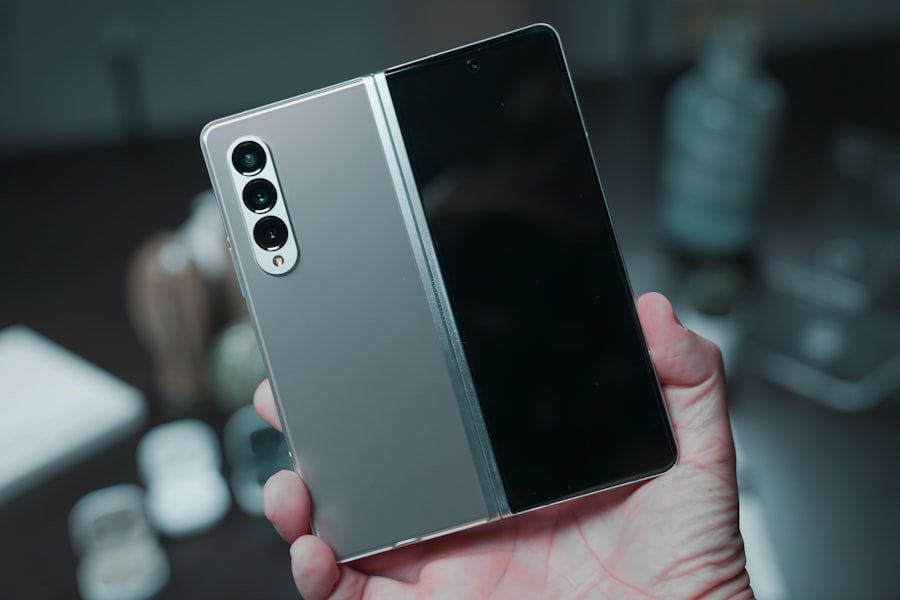Foldable smartphones have been making waves in the mobile technology industry in recent years. These innovative devices offer a unique and versatile user experience, combining the portability of a smartphone with the larger screen size of a tablet. With their growing popularity, it’s clear that foldable smartphones are the next big thing in mobile technology.
In this blog post, we will explore the evolution of mobile technology leading up to foldable smartphones, delve into what exactly foldable smartphones are and how they work, discuss the pros and cons of investing in these devices, and examine the impact they are having on the way we use our devices. We will also take a look at the top brands that are revolutionizing the foldable smartphone market, consider the challenges involved in designing and manufacturing these devices, and speculate on what the future holds for foldable smartphones.
Key Takeaways
- Foldable smartphones are the next big thing in mobile technology.
- Foldable smartphones have evolved from brick phones to sleek, flexible devices.
- Foldable smartphones work by using flexible screens and hinges to fold and unfold.
- The pros of foldable smartphones include larger screens and improved multitasking, while the cons include high prices and durability concerns.
- Top brands like Samsung and Huawei are leading the way in the foldable smartphone market.
The Evolution of Mobile Technology: From Brick Phones to Foldable Smartphones
Mobile phones have come a long way since their inception. The first mobile phones were large and bulky, earning them the nickname “brick phones.” These early devices were primarily used for making calls and had limited functionality. Over time, mobile phones became smaller and more portable, with advancements in technology allowing for additional features such as text messaging, internet browsing, and multimedia capabilities.
The introduction of smartphones revolutionized the mobile technology industry. These devices combined the functionality of a phone with that of a computer, offering users access to a wide range of applications and services. Smartphones continued to evolve, with improvements in design and technology leading to thinner and more powerful devices. However, one limitation remained: the size of the screen.
This limitation is what led to the development of foldable smartphones. By allowing the screen to fold or unfold, these devices offer users the best of both worlds – a compact device for easy portability and a larger screen for enhanced viewing and productivity. Foldable smartphones represent the next step in the evolution of mobile technology, providing a solution to the screen size dilemma that has plagued smartphone users for years.
What Are Foldable Smartphones and How Do They Work?
Foldable smartphones are a new category of mobile devices that feature flexible displays that can be folded or unfolded. Unlike traditional smartphones, which have a fixed screen size, foldable smartphones offer users the ability to switch between a compact form factor and a larger screen size.
There are two main types of foldable smartphones: inward folding and outward folding. Inward folding devices, as the name suggests, fold inwards, with the screen on the inside when folded. Outward folding devices, on the other hand, fold outwards, with the screen on the outside when folded.
The technology behind foldable smartphones is complex and involves several key components. The most important component is the flexible display, which is made up of multiple layers of thin materials that can bend without breaking. These layers include a flexible OLED panel, a touch-sensitive layer, and a protective layer.
To achieve the folding mechanism, foldable smartphones use hinges or other mechanisms that allow the device to bend without damaging the display. These hinges are designed to be durable and withstand repeated folding and unfolding.
The Pros and Cons of Foldable Smartphones: Is It Worth the Investment?
| Pros | Cons |
|---|---|
| 1. Larger screen size when unfolded | 1. Expensive compared to traditional smartphones |
| 2. More portable and compact when folded | 2. Durability concerns with folding mechanism |
| 3. Multitasking capabilities with split-screen mode | 3. Limited availability and options in the market |
| 4. Unique and innovative design | 4. Heavier and thicker than traditional smartphones |
| 5. Improved battery life due to larger battery capacity | 5. Limited app compatibility with folding screens |
As with any new technology, there are pros and cons to consider when it comes to foldable smartphones. On the positive side, these devices offer a larger screen size in a compact form factor, allowing for enhanced productivity and multimedia experiences. They also provide a unique and futuristic design that sets them apart from traditional smartphones.
However, there are also some drawbacks to consider. One of the main concerns is durability. Foldable smartphones are still relatively new, and there have been reports of issues with the durability of the flexible displays. Some users have experienced screen creasing or even complete display failure after extended use.
Another consideration is the price. Foldable smartphones are currently more expensive than traditional smartphones, with prices ranging from $1,000 to $2,000 or more. This high price point may deter some consumers from investing in these devices.
Despite these drawbacks, many believe that foldable smartphones are worth the investment. The unique features and design elements they offer, coupled with the potential for future advancements in technology, make them an exciting prospect for tech enthusiasts and early adopters.
The Top Brands That Are Revolutionizing the Foldable Smartphone Market
Several top brands are leading the way in foldable smartphone technology. These brands are pushing the boundaries of what is possible with mobile devices and shaping the future of mobile technology.
Samsung is one of the key players in the foldable smartphone market. The company’s Galaxy Fold was one of the first commercially available foldable smartphones and received positive reviews for its innovative design and functionality. Samsung has since released several other foldable devices, including the Galaxy Z Flip and the Galaxy Z Fold 2, further solidifying its position as a leader in this space.
Another major player in the foldable smartphone market is Huawei. The company’s Mate X series has garnered attention for its sleek design and impressive specifications. Huawei has been at the forefront of foldable smartphone technology, investing heavily in research and development to bring innovative devices to market.
Motorola is also making waves in the foldable smartphone market with its Razr series. The company’s latest offering, the Motorola Razr 5G, combines nostalgia with modern technology, featuring a foldable display reminiscent of the iconic Razr flip phones of the past.
These brands, along with others such as Xiaomi and Oppo, are driving innovation in the foldable smartphone market and shaping the future of mobile technology.
How Foldable Smartphones Are Changing the Way We Use Our Devices

Foldable smartphones are not just a novelty; they are changing the way we interact with our devices. The larger screen size offered by these devices allows for enhanced productivity, making tasks such as multitasking, content creation, and gaming more enjoyable and efficient.
Foldable smartphones also offer new possibilities for entertainment. With a larger screen, users can enjoy a more immersive viewing experience when watching movies or playing games. The ability to fold and unfold the device also opens up new possibilities for creative content consumption, such as reading e-books or viewing digital artwork.
Communication is another area where foldable smartphones are making an impact. The larger screen size makes video calls more engaging, allowing users to see their loved ones or colleagues in greater detail. The ability to fold the device also offers privacy during video calls, as the screen can be folded to create a smaller, more intimate viewing area.
While there are many benefits to using foldable smartphones, there are also potential drawbacks and challenges to consider. One of the main challenges is software optimization. Foldable smartphones require specialized software to take full advantage of their unique features and form factor. Developers need to adapt their applications to work seamlessly on foldable displays, which can be a time-consuming and complex process.
Another challenge is the potential for increased power consumption. The larger screens and more powerful hardware required for foldable smartphones may result in higher energy consumption, leading to shorter battery life. This is an area that manufacturers will need to address in order to provide a satisfactory user experience.
The Impact of Foldable Smartphones on the Future of Mobile Technology
Foldable smartphones have the potential to have a significant long-term impact on the mobile technology industry. Their unique design and functionality open up new possibilities for device manufacturers, developers, and consumers alike.
From a consumer perspective, foldable smartphones offer a more versatile and immersive user experience. The ability to switch between a compact form factor and a larger screen size provides users with the best of both worlds, allowing them to adapt their device to their specific needs and preferences.
For device manufacturers, foldable smartphones represent a new frontier in design and technology. These devices require innovative engineering and manufacturing processes to ensure durability and reliability. Manufacturers that can successfully navigate the challenges of designing and manufacturing foldable smartphones will be well-positioned to lead the market in the future.
Developers also stand to benefit from the rise of foldable smartphones. The unique form factor of these devices opens up new possibilities for app design and functionality. Developers can create applications that take full advantage of the larger screen size, offering users a more immersive and engaging experience.
The Challenges of Designing and Manufacturing Foldable Smartphones
Designing and manufacturing foldable smartphones is no easy task. There are several challenges that must be overcome in order to bring these devices to market.
One of the main challenges is ensuring durability. Foldable smartphones need to withstand repeated folding and unfolding without compromising the integrity of the display or other components. This requires the use of high-quality materials and innovative engineering solutions.
Another challenge is achieving a seamless user experience. Foldable smartphones require specialized software to optimize the user interface and ensure smooth transitions between different screen configurations. This software optimization can be complex and time-consuming, requiring collaboration between device manufacturers and app developers.
Cost is also a significant challenge when it comes to foldable smartphones. The technology required to produce these devices is still relatively new and expensive, resulting in higher manufacturing costs. This, in turn, leads to higher retail prices for consumers, making foldable smartphones less accessible to a wider audience.
Despite these challenges, manufacturers are making significant progress in designing and manufacturing foldable smartphones. As technology continues to advance and economies of scale are realized, it is likely that the cost and availability of these devices will improve over time.
The Role of Foldable Smartphones in the Growing Trend of Mobile Gaming
Mobile gaming is a rapidly growing industry, with more and more people turning to their smartphones for entertainment. Foldable smartphones have the potential to enhance the gaming experience by offering a larger screen size and more immersive gameplay.
The larger screen size of foldable smartphones allows for a more immersive gaming experience. Players can enjoy games with more detail and larger viewing areas, making gameplay more engaging and enjoyable. The ability to fold and unfold the device also opens up new possibilities for gaming, such as split-screen multiplayer or using one half of the screen as a controller.
However, there are also potential challenges and drawbacks to gaming on foldable smartphones. One concern is the increased power consumption. Gaming can be resource-intensive, requiring powerful hardware and consuming a significant amount of energy. The larger screens and more powerful processors required for foldable smartphones may result in higher power consumption, leading to shorter battery life.
Another challenge is software optimization. Game developers need to adapt their games to work seamlessly on foldable displays, taking into account the unique form factor and screen configurations. This can be a complex process that requires time and resources.
Despite these challenges, foldable smartphones have the potential to revolutionize mobile gaming by offering a more immersive and versatile gaming experience. As technology continues to advance and developers adapt their games to work seamlessly on foldable displays, we can expect to see even more exciting developments in this space.
The Future of Foldable Smartphones: What Can We Expect in the Next Decade?
The future of foldable smartphones is bright, with many exciting developments on the horizon. As technology continues to advance, we can expect to see improvements in design, durability, and functionality.
One area that is likely to see significant advancements is the flexible display technology used in foldable smartphones. Manufacturers are investing heavily in research and development to improve the durability and reliability of these displays, addressing concerns such as screen creasing and display failure. We can expect to see more robust and durable flexible displays in the future, making foldable smartphones even more appealing to consumers.
Another area of potential development is software optimization. As more developers adapt their applications to work seamlessly on foldable displays, we can expect to see a wider range of apps and games that take full advantage of the unique features and form factor of these devices. This will further enhance the user experience and open up new possibilities for productivity, entertainment, and communication.
In terms of design, we can expect to see more innovative form factors and configurations. Manufacturers are already experimenting with different folding mechanisms and screen configurations, and this trend is likely to continue. We may see devices that can fold in multiple directions or devices that can transform into different form factors, such as a smartphone that can unfold into a tablet or a laptop.
Foldable smartphones are the next big thing in mobile technology. These innovative devices offer a unique and versatile user experience, combining the portability of a smartphone with the larger screen size of a tablet. With their growing popularity, it’s clear that foldable smartphones are here to stay.
In this blog post, we explored the evolution of mobile technology leading up to foldable smartphones, delved into what exactly foldable smartphones are and how they work, discussed the pros and cons of investing in these devices, and examined the impact they are having on the way we use our devices. We also took a look at the top brands that are revolutionizing the foldable smartphone market, considered the challenges involved in designing and manufacturing these devices, and speculated on what the future holds for foldable smartphones.
Foldable smartphones represent an exciting new frontier in mobile technology. As technology continues to advance and manufacturers overcome the challenges associated with designing and manufacturing these devices, we can expect to see even more exciting developments in the years to come. Whether you’re a tech enthusiast or simply someone looking for a more versatile and immersive user experience, foldable smartphones are definitely worth keeping an eye on.
If you’re interested in smartphones that fold, you might also want to check out the article on the Umidigi Bison 2 Rugged Smartphone. This device is not only durable but also packed with features that make it perfect for outdoor enthusiasts. With its folding design, it offers a unique and versatile user experience. Learn more about the Umidigi Bison 2 Rugged Smartphone here.








